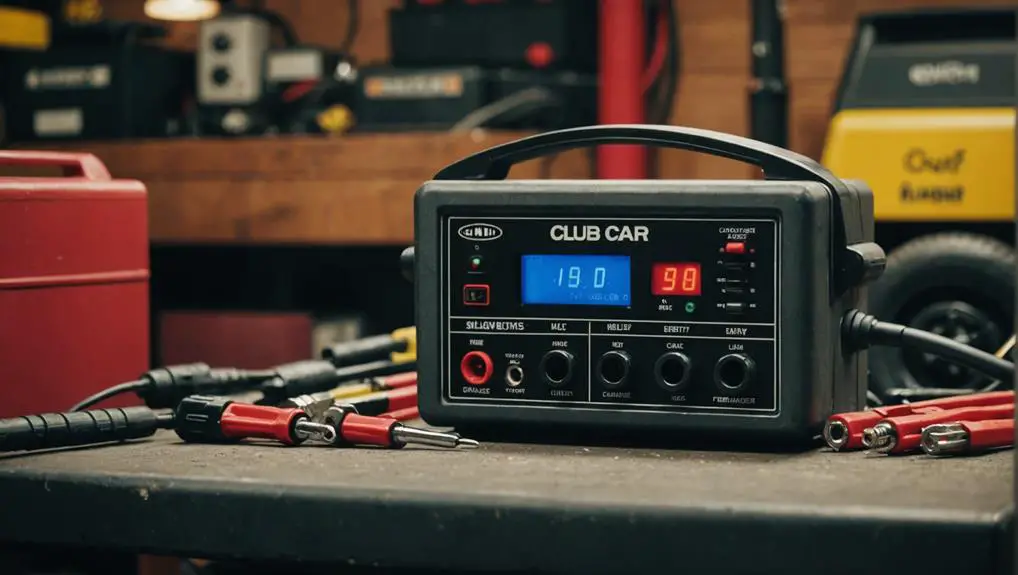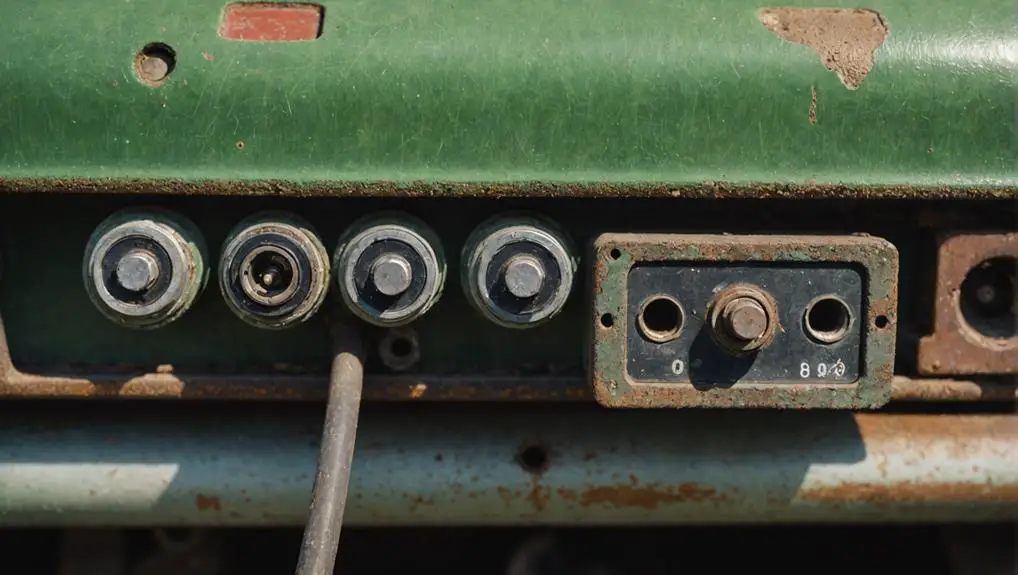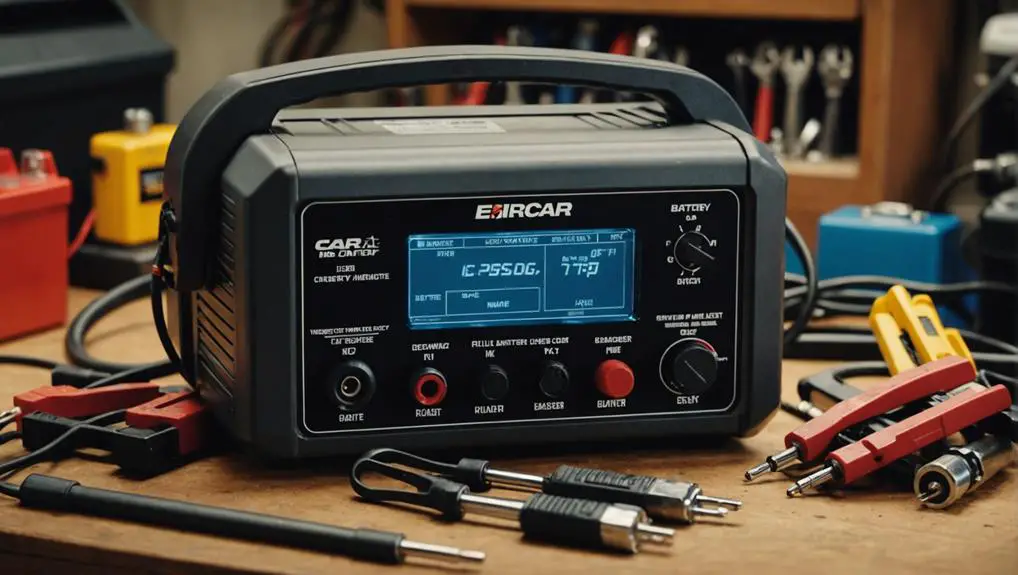When your Club Car battery charger isn't functioning as it should, it can be frustrating. You might find yourself wondering why it won't turn on or why those indicator lights are blinking. Start by checking the power source and inspecting the cord for any visible damage. If you're experiencing slow charging or overheating, these could signal deeper issues. Understanding these common problems is essential, but knowing how to fix them effectively can make all the difference in keeping your golf cart running smoothly. What are the next steps you should take to troubleshoot these issues?
Key Takeaways
- Ensure the charger is plugged into a functional outlet and inspect the power cord for damage before troubleshooting further.
- Confirm secure connections between the charger and battery; clean any corrosion to improve charging efficiency.
- If the charger won't turn on, check the battery voltage with a multimeter to assess battery health.
- Monitor for slow charging times; inspect battery condition and ensure adherence to manufacturer-recommended charging times.
- Address overheating by ensuring proper ventilation, adhering to charging times, and consulting a professional if issues persist.
Charger Won't Turn On
When your Club Car battery charger won't turn on, it can be frustrating, but troubleshooting the issue can often lead to a quick solution.
Start by checking the power source. Verify the charger is plugged into a functioning outlet. If you're using an extension cord, try connecting the charger directly to the outlet to rule out any cord issues.
Next, inspect the charger's power cord for any visible damage. Frayed or broken wires can prevent the charger from receiving power. If you notice any damage, replace the cord.
You should also examine the batteries themselves. A completely dead battery may not activate the charger. If possible, check the battery voltage with a multimeter. If the voltage is markedly low, consider charging the batteries separately or replacing them if they're old or damaged.
Lastly, look for any signs of internal damage on the charger. If you've tried these steps and the charger still won't turn on, it may require professional servicing or replacement.
Blinking Indicator Light
A blinking indicator light on your Club Car battery charger often signals an issue that needs attention. This light can indicate various problems, and it's vital to diagnose them quickly to avoid further complications.
First, check the connection between the charger and the battery. A loose or corroded connection can cause the light to blink. Make sure the terminals are clean and securely attached.
Next, verify that the battery itself is in good condition. If the battery's voltage is too low or it's nearing the end of its life, the charger may struggle to function properly.
Lastly, consider the charger's settings. If you've recently adjusted any settings, confirm they align with your battery specifications.
Here are some common reasons for a blinking indicator light:
- Loose or corroded battery connections
- Insufficient battery voltage or age
- Incorrect charger settings for your specific battery type
Address these issues promptly. Ignoring the blinking light can lead to inefficient charging and potential damage to your battery or charger.
Always consult your user manual for specific troubleshooting guidance tailored to your model.
Slow Charging Times

If your Club Car battery charger is taking longer than usual to charge, it could indicate underlying issues that need addressing.
First, check the battery connections. Corroded or loose terminals can impede the charging process. Clean the terminals and verify they're securely connected.
Next, examine the charger itself. Look for any visible damage or wear. A malfunctioning charger may not deliver the required voltage and can result in prolonged charging times. If you suspect the charger is at fault, consider testing it with a multimeter to verify its output.
Also, assess the battery's condition. Old or damaged batteries often struggle to hold a charge, leading to longer charging times. If the battery is over three to five years old, it might be time for a replacement.
Lastly, consider the ambient temperature. Charging in extremely cold or hot conditions can affect charging efficiency. Ideally, keep your charger in a temperature-controlled environment.
Overheating Issues
Charging issues can also manifest as overheating, which poses significant risks to both your charger and batteries. When your charger overheats, it can lead to battery damage, reduced performance, and even fire hazards.
To manage overheating, keep an eye on the following potential causes:
- Ventilation: Make sure that your charger is in a well-ventilated area. Poor airflow can trap heat, leading to overheating.
- Charging Time: Overcharging your batteries can increase heat generation. Always follow the manufacturer's recommended charging time.
- Connections: Loose or corroded connections can cause resistance, generating excess heat. Regularly inspect and clean the connections to maintain peak performance.
If you notice your charger consistently overheating, it's crucial to address the issue promptly. Turn off the charger and allow it to cool down before attempting to recharge your batteries again.
If overheating persists, consider consulting a professional technician. Regular maintenance and vigilance can help you avoid overheating issues and guarantee your charger and batteries function safely and effectively.
Corroded Battery Connections

Corroded battery connections can greatly impact your Club Car's performance.
You'll want to identify symptoms like a buildup of white, powdery residue or loose connections.
Once you spot these issues, cleaning techniques and prevention strategies can help maintain ideal battery function.
Identifying Corrosion Symptoms
Often, you'll notice signs of corrosion at the battery connections, which can hinder the performance of your Club Car battery charger. Identifying these symptoms early is essential to maintaining ideal battery health.
Corrosion typically appears as a white, ashy substance or a greenish tint around the terminals. If you see any of these signs, it's imperative to address the issue promptly.
Here are key symptoms to look for:
- Discoloration: Any unusual color on the battery terminals, especially white or greenish hues, indicates corrosion.
- Crusty Build-Up: A crusty or powdery residue around the connections is a clear sign that corrosion is present.
- Loose Connections: If the battery terminals feel loose or don't seem to fit snugly, corrosion might be the culprit.
Ignoring these symptoms can lead to poor electrical connections, decreased battery efficiency, and ultimately, reduced performance of your charger.
Regular inspections of your battery connections will help you catch these issues early, ensuring your Club Car operates smoothly. Stay proactive and keep an eye on those terminals!
Cleaning Techniques Explained
Once you've identified corrosion on your battery connections, it's important to clean them properly to restore peak performance.
Start by confirming your charger is unplugged and the vehicle is turned off. Safety goggles and gloves are essential to protect yourself from any harmful chemicals.
Use a mixture of baking soda and water—about one tablespoon of baking soda in a cup of water. This solution neutralizes the acid corrosion. Apply it to the corroded connections using an old toothbrush or a small brush. Gently scrub the area until you see the corrosion lifting away.
After cleaning, rinse the connections with plain water to remove any residue from the baking soda. Make sure to dry the connections thoroughly with a clean cloth, as moisture can lead to further corrosion.
Once everything is dry, reconnect the battery terminals, confirming they're tight but not over-torqued. If your battery connectors are severely corroded, consider replacing them.
Regularly check your connections after cleaning to confirm they remain corrosion-free and maintain peak performance in your Club Car battery charger system.
Prevention Strategies Offered
To keep corrosion at bay, you should regularly inspect your battery connections and clean them as needed. Corrosion can lead to poor electrical connections, affecting your Club Car's performance.
By maintaining clean connections, you guarantee peak power flow and prolong the lifespan of your batteries.
Here are some prevention strategies to take into account:
- Use Anti-Corrosion Grease: Apply a thin layer of anti-corrosion grease to battery terminals after cleaning. This creates a protective barrier against moisture and contaminants.
- Tighten Connections: Make sure all connections are tight. Loose connections can generate heat and lead to corrosion over time.
- Store Properly: If you're storing your Club Car for an extended period, disconnect the batteries and store them in a cool, dry place. This minimizes exposure to elements that can cause corrosion.
Regular maintenance not only prevents corrosion but also guarantees your battery charger operates efficiently.
Incompatible Charger Models
Using the wrong charger model can lead to significant issues with your Club Car's battery performance. Each Club Car model requires a specific charger designed for its voltage and battery chemistry. When you use an incompatible charger, you risk overcharging or undercharging the batteries. This can shorten their lifespan, reduce efficiency, and even cause permanent damage.
To guarantee compatibility, always check the specifications of your charger against your battery's requirements. Look for details such as voltage (typically 36V or 48V for Club Cars) and the type of battery (lead-acid or lithium-ion). Using a charger that doesn't match these specifications can result in erratic charging cycles, which could ultimately lead to battery failure.
If you've mistakenly used an incompatible charger, disconnect it immediately and assess your battery's condition. Monitor for any signs of swelling, leakage, or unusual heat, as these can indicate damage.
In such cases, consult a qualified technician for advice on how to proceed. Always keep the right charger on hand to prevent future issues, guaranteeing your Club Car operates at its best.
Regular Maintenance Tips

Regular maintenance is essential for keeping your Club Car battery charger functioning at its best. By following a few straightforward practices, you can guarantee longevity and peak performance.
Here are some key maintenance tips to keep in mind:
- Inspect Connections: Regularly check the connections for corrosion or damage. Clean any buildup with a suitable solution to guarantee a secure connection.
- Clean the Charger: Dust and debris can accumulate on your charger. Wipe it down with a soft cloth to prevent overheating and guarantee proper ventilation.
- Monitor Charging Cycles: Keep track of how often your charger is used. Regularly assess the charging cycles to avoid overcharging, which can degrade battery life.
Frequently Asked Questions
How Can I Tell if My Battery Needs Replacing?
To determine if your battery needs replacing, start by checking its voltage with a multimeter. A reading below the manufacturer's specified level often indicates a weak battery.
Also, inspect for physical signs like bulging, corrosion, or leakage. If your battery struggles to hold a charge or discharges quickly, it's likely time for a replacement.
What Safety Precautions Should I Take While Troubleshooting?
When you're troubleshooting, safety's as essential as a knight's armor in a dragon's lair. Always disconnect the power before starting, and wear gloves and goggles to protect yourself from any hazardous materials.
Make certain you're in a well-ventilated area to avoid gas buildup. Keep flammable objects away, and never work with wet hands.
Can Weather Conditions Affect Charger Performance?
Yes, weather conditions can greatly affect charger performance.
Extreme temperatures, both hot and cold, can impact battery chemistry, leading to inefficient charging.
If it's too cold, the charger may struggle to deliver the necessary voltage; in hot weather, overheating can trigger safety mechanisms that halt charging.
It's best to monitor the environment and, if possible, charge in moderate conditions to guarantee peak performance and longevity of your battery charger.
How Often Should I Inspect My Charger?
You should inspect your charger regularly—at least once a month.
Imagine discovering a hidden issue just before a big trip. Regular checks help you catch wear, frayed cables, or loose connections early on.
If you've been using it in extreme conditions, inspect even more frequently. Keeping an eye on its performance guarantees reliability and longevity.
Don't wait for problems to arise; proactive maintenance is key to avoiding unexpected downtime.
Where Can I Find Replacement Parts for My Charger?
You can find replacement parts for your charger through various channels.
Start by checking the manufacturer's website, as they often provide direct sales or a list of authorized dealers.
Online marketplaces like Amazon or eBay also offer a wide selection.
Local golf cart dealerships might stock compatible parts too.
Before purchasing, verify the parts are compatible with your specific charger model to avoid any issues during installation.
Conclusion
In troubleshooting your Club Car battery charger, think of it like maintaining a well-tuned engine. Just as a car needs regular oil changes to perform at its best, your charger benefits from routine checks and cleaning. Addressing issues like overheating or slow charging can prevent more significant problems down the line. By staying proactive and attentive, you'll keep your charger running smoothly, ensuring your ride remains reliable and enjoyable for all your adventures on the course or the road.